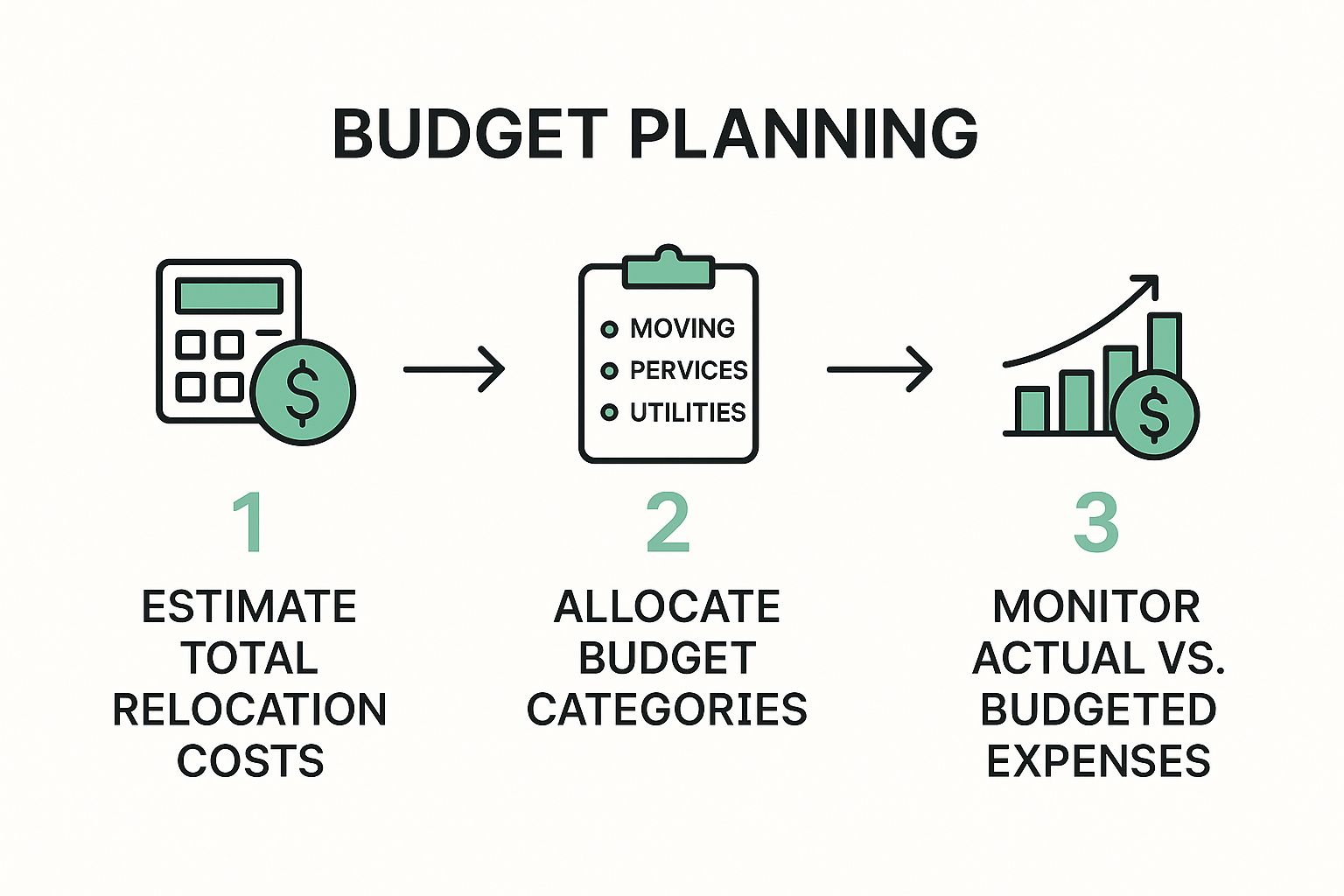An effective office relocation plan is more than just a to-do list; it's the detailed blueprint that turns a hugely complex project into a manageable, step-by-step process. Think of it as your roadmap—it lays out your strategic goals, sets a realistic budget, and assigns clear responsibilities to make sure the transition to your new workspace is smooth and successful, with minimal disruption to your business.
Building Your Relocation Blueprint

Moving an entire office is a massive business project, not just a logistical puzzle. It touches every single part of your organisation. A well-thought-out relocation plan is your best defence against the chaos that can so easily derail operations, drain the budget, and seriously dent team morale.
The very first thing you need to do is nail down the "why" behind the move.
Without clear objectives, your relocation will lack direction. Are you moving to accommodate a growing team? To upgrade to better facilities? Or to position your business in a more strategic location? Getting these goals crystal clear from the get-go will shape every decision you make, from choosing the right property to designing the new floor plan.
For example, a tech startup might need a spot with excellent public transport links and modern perks to attract top talent. A law firm, on the other hand, might prioritise a prestigious address that boosts its brand image and provides impressive client-facing meeting rooms.
Define Your Strategic Goals
The reasons for an office move can vary, but they usually fall into a few key categories. Pinpointing your primary driver is absolutely crucial for a successful outcome.
Common goals we see include:
- Business Growth: You've simply outgrown your current space and need more room for new hires, equipment, or inventory.
- Cost Optimisation: Your current lease is bleeding you dry, and a move offers a chance for significant savings on rent or running costs.
- Talent Attraction: Shifting to a more desirable or accessible area can make your company a much more attractive proposition for potential employees.
- Brand Enhancement: A fresh, modern office can project a more successful and forward-thinking image to both clients and partners.
Recent market trends show a clear "flight to centrality" happening right across Australia. Businesses are increasingly consolidating into prime, well-connected CBD locations, like Sydney’s Financial Core and Melbourne’s Eastern and Western Cores, to attract and keep the best people. This shift towards central hubs is expected to support rental growth as new supply starts to tighten up.
Assemble Your Internal Move Committee
Trust me on this: an office move should never be a one-person job. You need to form a dedicated internal committee with people from key departments. This team will act as the command centre for the entire project.
A common mistake is to dump the entire move on one person in HR or operations. This creates a massive bottleneck and completely overlooks the unique needs of different departments. A cross-functional committee ensures everyone’s perspective is heard.
Your move committee really needs members from:
- IT: They'll manage the incredibly complex migration of servers, networks, and all your communication systems.
- Human Resources: To handle employee communications, field concerns, and manage the human side of the change.
- Finance: For overseeing the budget, meticulously tracking expenses, and managing all vendor payments.
- Department Heads: They represent the specific needs and workflows of their teams, making sure the new layout actually works for everyone.
Set A Realistic Preliminary Budget
Your preliminary budget is a non-negotiable part of your relocation plan. It has to be comprehensive, covering not just the obvious big-ticket items but also the hidden costs that can pop up and quickly spiral out of control.
Start by listing every potential expense you can think of. These include:
- Professional Movers: The cost of packing, transporting, and unpacking all your assets.
- New Office Fit-Out: All the expenses related to construction, data cabling, painting, and installing new furniture.
- Technology Upgrades: The potential cost of new servers, phone systems, or network infrastructure.
- Dilapidation Costs: The expense of returning your old office to its original state, as required by your lease agreement.
- Contingency Fund: Always, always allocate at least 10-15% of your total budget for unexpected issues. They will happen.
A thorough budget sets realistic expectations from day one and helps you avoid nasty financial surprises down the track. For a more granular breakdown, using a detailed https://emmanueltransport.net.au/office-relocation-checklist/ can help you itemise every single potential cost.
Navigating Pre-Move Logistics
With your big-picture strategy sorted, it’s time to roll up your sleeves and dive into the nitty-gritty of the pre-move phase. This stage is less about the ‘why’ and all about the ‘how’. Getting these details right is what separates a smooth, organised relocation from a chaotic scramble.
The first, most crucial step is a full-scale asset audit. You can't plan a move without knowing exactly what you're moving. This means creating a detailed inventory of everything—from servers and workstations to the ancient microwave in the kitchen and boxes of archived files.
This isn’t just about counting chairs; it’s a strategic financial exercise. For every single item, you need to make a call: keep, replace, sell, or dispose. That server that’s been humming along for five years? It might be cheaper to replace it than to pay a specialist to migrate it. Those tired-looking desks could be sold or donated, which not only cuts down your removalist bill but can also help fund new, more ergonomic furniture for the new space.
Vetting And Selecting Your Move Partners
Let's be clear: you can’t do this alone. Assembling a crack team of specialist vendors is one of the most important things you'll do. Rushing this or just picking the cheapest quote is a classic mistake that almost always leads to trouble down the line. You need reliable partners who’ve been through the pressures of a commercial move before.
Your go-to vendor list should include:
- Commercial Removalists: Find a company that specialises in office moves, not just residential ones. They'll have the right insurance, the right gear for sensitive IT equipment, and an understanding of business downtime.
- IT Migration Specialists: This is non-negotiable. These are the experts who will handle the disconnection, secure transport, and reconnection of your entire tech backbone—servers, networks, phone systems, the lot.
- Interior Designers or Space Planners: If you’re planning a new fit-out, these professionals are essential. They’ll help you create a workspace that's not just functional but actually helps your team do their best work.
- Cleaning and Waste Removal Services: You’ll need cleaners for both your old and new spaces to manage the end-of-lease clean and get rid of all the junk you’re not taking with you.
When you’re talking to potential partners, always ask for case studies or references from businesses similar to yours. Don’t be shy about checking their insurance and safety records, and make sure you understand their process for dealing with unexpected hiccups.

As you can see, managing your budget isn't a one-off task. It's a continuous cycle of estimating, allocating funds, and keeping a close watch on spending as you go.
To help you stay on track, here's a high-level look at the critical milestones and when you should be tackling them.
Key Relocation Milestones
| Timeframe Before Move | Key Tasks & Milestones |
|---|---|
| 6-9 Months | Finalise new lease. Appoint move manager. Set budget. Begin vendor research (designers, removalists). |
| 4-6 Months | Engage space planner/designer. Finalise new office layout. Order new furniture & equipment. |
| 2-4 Months | Select and book removalists & IT specialists. Begin asset audit. Develop communication plan. |
| 1-2 Months | Notify clients & suppliers. Arrange mail redirection. Begin distributing packing materials. |
| 2-4 Weeks | Confirm move day schedule. Complete staff packing. Finalise IT migration plan. |
| 1 Week | Final pre-move briefing with all staff and vendors. Label everything. Back up all data. |
This timeline isn't set in stone, of course, but it gives you a solid framework to prevent last-minute panic.
Crafting A Clear Communication Strategy
An office move can stir up a lot of uncertainty for your team, clients, and suppliers. A proactive communication plan is your best defence against anxiety and rumours. Silence is never golden here; you need to get ahead of the story with clear, regular updates.
Internally, your plan should answer the questions everyone is thinking:
- What’s the exact timeline?
- What will the new office actually be like? (Think layouts, amenities, photos!)
- How will this affect my commute and daily routine?
- What do I need to do to help with the packing?
For external stakeholders, like clients and suppliers, the message is all about continuity. Reassure them that it’s business as usual and give them plenty of notice about your new address and contact details. Many of the same principles in this moving house change of address checklist are just as relevant for a business relocation.
Keeping everyone in the loop transforms potential anxiety into shared excitement. When your team feels included and clients feel prioritised, the move becomes a positive group effort instead of a major disruption.
Designing The New Office Layout
Finally, you need a detailed floor plan and seating chart for the new office. This is where your vision for the new space becomes a reality. A well-thought-out layout is absolutely essential for a smooth, organised move-in day.
Work closely with your department heads to map out where every team and individual will sit. This is more than just plonking down desks; it's about optimising workflow. For instance, you’d probably want the sales and marketing teams near each other to encourage collaboration, while the finance team might need a quieter, more self-contained area.
Once you’ve locked it in, this floor plan becomes the bible for your removalists, IT team, and staff. A simple but incredibly effective trick is to use a colour-coded labelling system that matches the plan. A green sticker could mean "Sales, First Floor," while a blue one means "IT Department, Ground Floor." This simple system ensures every box and desk lands exactly where it’s supposed to go, saving you a massive headache on move-in day.
Looking After Your People: The Human Side of an Office Move
Let’s be honest: an office move is more than just shifting furniture and IT gear. It's about uprooting your team. The human element is easily the trickiest, most sensitive part of the whole operation. If you overlook how this change impacts your people, you risk starting life in your new space with morale at an all-time low and anxiety through the roof.
Getting this right comes down to empathy, clear communication, and a solid plan. Your team will have a hundred questions, ranging from the practical ("What's my new commute?") to the personal ("How will this mess with my daily routine?"). Your job is to anticipate these questions and answer them with honest, consistent information.
Tell Them the ‘Why’
The very first thing you need to do is explain why you're moving. Don't just drop a new address in an email and call it a day. You need to sell the vision. Is this new office designed to help everyone collaborate better? Does it have amazing new facilities that will improve work-life balance? Frame the move as a genuine step forward for the company, and therefore, for everyone who works there.
When you get on the front foot and control the story, you turn a potentially stressful event into the start of an exciting new chapter. This isn't a one-and-done email, either. It needs a layered approach.
- Host a Town Hall: Get leadership in front of everyone to present the vision and take questions on the spot. It shows you’re not hiding from the tough stuff.
- Keep the Updates Coming: Send out regular newsletters with progress photos, reminders of key dates, and even fun tips about the new neighbourhood.
- Set Up a Dedicated Slack Channel: Create an informal space where people can ask questions in real time and just chat about the move.
The goal is simple: make information easy to find and create a space where people feel safe to voice their concerns. When people feel heard, you'll find their natural resistance to change starts to melt away.
Get Your Team Involved
One of the best ways to get people on board is to give them a say in the process. While they can't pick the building, you can absolutely empower them to shape their new workspace in ways that matter. This builds a powerful sense of ownership and gets people genuinely excited.
Think about setting up a few small, volunteer committees to tackle specific parts of the new office. For instance, you could let a group of employees decide on:
- The furniture and overall vibe for the new kitchen or break-out area.
- Creative names for the new meeting rooms.
- What kind of coffee machine you'll get or the snacks you'll stock.
These might sound like minor details in the grand scheme of your relocation plan, but they are the very things that shape your team's day-to-day life at work. Giving them control over these elements sends a clear message: their comfort and happiness are a top priority.
Involving your team in the fun parts of the move shifts their perspective. They stop being passive recipients of a big corporate decision and become active creators of their future workspace. It’s a simple trick, but it works wonders for morale.
Build the Buzz for Day One
As moving day gets closer, shift your focus from managing worries to building genuine excitement. You want the first day in the new office to feel like a celebration, not just another Monday. A fantastic Day One experience can set a positive tone for the months that follow.
A great way to start is by organising pre-move tours of the new site. Letting people walk through the space while it’s still being fitted out helps them picture themselves there and makes the change feel less abstract.
Next, plan a great welcome. Something as simple as a thoughtful welcome kit waiting on each person’s desk can make a massive difference.
What to pop in a welcome kit:
- A personal welcome letter from the CEO.
- A curated map of the local area, pointing out the best cafes, lunch spots, and gyms.
- Some fresh company swag, like a new mug or a quality notebook.
- A gift card for a local coffee shop to get them out and exploring.
Finally, make the first day itself special. Cater a celebratory lunch, knock off an hour early, or organise some casual after-work drinks. Kicking things off with a burst of positive energy reinforces the message that this move is a great thing for everyone.
Executing a Seamless Physical Move

This is it. The moment where all those spreadsheets, meetings, and tough decisions you’ve made finally come to life. The physical move is where precision planning pays off, and getting it right is the secret to minimising painful, costly downtime.
The classic goal is to close the doors on the old office on a Friday afternoon and have everyone logged in and working in the new space by Monday morning. Pulling this off comes down to one thing: flawless coordination with your vendors. In these final days, your relationship with your commercial removalist is everything.
They're not just moving boxes; they're your logistical partners on the ground. You’ll want to work closely with them to nail down a crystal-clear system for packing, labelling, and transport. A simple, colour-coded labelling system that corresponds to the new floor plan is a battle-tested method. It ensures every box, chair, and computer monitor ends up exactly where it needs to be, not just piled in a random corner.
Prioritising Your Technology Migration
Moving desks and chairs is one thing, but migrating your entire IT infrastructure is another beast altogether. It’s a delicate, high-stakes operation. Your business runs on its data, connectivity, and communication systems, making this the one area where you simply cannot afford to get it wrong.
Your IT migration specialist should be your closest ally during the move itself. The aim here is to have your servers running, internet blazing, phones ringing, and the network fully accessible before your team even steps foot in the new building.
A solid IT migration timeline usually involves these key stages:
- Pre-Move Audit: A final, comprehensive check of all hardware and software dependencies.
- Data Backup: A full and, most importantly, verified backup of all company data just before anything gets unplugged.
- System Shutdown: A carefully sequenced shutdown of servers and network gear at the old office.
- Secure Transport: Using specialised equipment to safely move your most sensitive and valuable IT assets.
- Reconnection and Testing: Re-installing and then rigorously testing every single system at the new office to guarantee it's all working perfectly.
The most common point of failure in an office move is underestimating the complexity of the IT migration. I always advise clients to treat it as a separate, mission-critical project within the larger move. Honestly, if the phones and internet work on Monday morning, you’ve already won half the battle.
It’s also worth noting that wider economic shifts are shaping these decisions. Ongoing uncertainties are pushing some Australian companies to look at new locations, with many choosing regional hubs to attract talent without the big city price tag. Things like sustainability and support for hybrid work are now major factors, influencing not just where a company moves, but the technology it needs to thrive. You can get more insight into how these 2025 business relocation trends are impacting technology choices over on SIPcity's blog.
Final Checks and Handover Procedures
In the last few days before the move, you'll feel like you're being pulled in a dozen different directions. This is where a robust checklist becomes your best friend, making sure small but crucial details don't get lost in the chaos.
These final tasks are all about ensuring a clean exit from your old lease and a secure, smooth start in your new home.
Make sure your final pre-move checklist includes these non-negotiables:
- Final Insurance Review: Confirm your removalist has adequate insurance and that your own business policy covers goods in transit and the new premises from day one.
- Vendor Coordination: Jump on one last briefing call with all your key vendors—removalists, IT team, cleaners—to lock in arrival times, access details, and the schedule for the day.
- Access and Security: Get your hands on all keys, access cards, and security codes for the new building. Critically, make sure they are activated and tested before move day.
- Cleaning Services: Book the end-of-lease clean for the old office to satisfy your lease obligations. It’s also a great idea to book a pre-move clean for the new space so your team arrives to a fresh start.
- Utilities Finalisation: Confirm final meter readings and account closures for your old office. At the same time, double-check that power, water, and internet are all connected and active at the new location.
Executing the physical move is the culmination of all your hard work. It's a high-pressure, fast-paced period, but with clear communication, meticulous organisation, and strong vendor partnerships, you'll nail it. Getting this stage right means your team can walk into a fully functioning, welcoming new workspace, ready to kick off the company's next chapter with real momentum.
Settling In And Evaluating Success
The last box is unpacked and the removalist trucks have driven away, but don't close the book on your office relocation just yet. This final phase is all about tying up loose ends and making sure the new space actually delivers on its promise. It's where you lock in the long-term value of the entire project.
Before you let everyone get too comfortable, it's time for a meticulous walkthrough of the new office. Don't put this off. Grab your move committee, a clipboard, and your phone's camera, then comb through every single corner of the space. You're hunting for anything that isn't quite right.
This inspection is your chance to build a detailed "punch list" for your vendors—a formal list of all damages, incomplete tasks, or defects that need to be fixed before you even think about signing off on their final invoice. Trust me, it’s a critical step for accountability.
Creating And Managing Your Punch List
Your punch list needs to be specific and organised, because vague notes just won't cut it in a dispute. I’ve seen it happen.
For each issue you find, make sure you document:
- The exact location (e.g., "Meeting Room 3, south wall").
- A clear description of the problem (e.g., "Deep scratch in the paintwork, approx. 15cm long").
- A photo for undeniable visual proof.
- Which vendor is on the hook for the fix (e.g., movers, painters, IT).
Once you've got the list compiled, fire it off to the relevant vendors immediately. Give them a clear deadline for when you expect the issues to be resolved. This simple process ensures you get the quality finish you paid for and holds your partners accountable for their work.
Capturing Employee Feedback
While you’re checking the physical space, it's just as important to find out how your team is settling in. After all, the real success of an office move is measured by how well the new environment supports your people and their work. Anonymous surveys are a brilliant tool for this.
Get straight to the point with your questions:
- What’s working really well in the new layout?
- What immediate frustrations have you run into? (Think noise levels, lighting, or access to printers).
- Do you have the right setup and tools to do your job effectively?
Collecting this feedback within the first few weeks is crucial. It lets you sort out any teething problems quickly, which shows your team that their comfort and productivity are a genuine priority. It also gives you invaluable data for any future projects.
Updating Your Business Presence
With your team finding their new rhythm, the next job is a bit of a grind, but it's essential: updating your business address across every single platform and official record. If you miss even one, you risk lost mail, confused clients, and some major administrative headaches down the line.
Your address change checklist has to be comprehensive, covering:
- Official Registrations: ASIC, ABR, and any industry-specific bodies.
- Financials: Every bank account, credit card, and especially your insurance providers.
- Online Profiles: Google Business Profile, all your social media accounts, and any industry directories you're listed in.
- Marketing Materials: Your website footer, email signatures, business cards, and company letterhead.
- Suppliers and Clients: Send out a formal notification to all your key partners so they know where to find you.
This kind of administrative polish matters. Corporate relocations are always influenced by the broader market, and according to the Property Council of Australia, office vacancy rates nudged up to 13.7% in early 2025. Even with positive demand in CBDs, new supply outpaced it. In this evolving landscape, a flawless move—including perfect post-move admin—is key to getting the most out of your investment. You can dig into the numbers in this analysis of Australian office vacancy trends.
Conducting The Final Project Debrief
Finally, you can officially close out your office relocation plan with two last tasks: a final budget reconciliation and a project debrief. Sit down and compare all your actual expenses against your initial budget. This will show you any overspends and help you understand exactly where every dollar went.
Then, get the move committee together for a debrief. This is your chance to capture all the lessons learned. Talk openly about what went brilliantly, what challenges blindsided you, and what you’d do differently next time. Documenting these findings creates a powerful internal case study that will make your next big business project run even more smoothly.
Answering Your Biggest Office Relocation Questions

Even with the most solid plan, a few nagging questions always seem to pop up during an office move. It’s a huge undertaking with a lot of moving parts, so a bit of uncertainty is completely normal. Let’s tackle some of the most common queries I hear from businesses to give you some clarity.
How Far in Advance Should We Start Planning?
The golden rule I always tell my clients is to start far earlier than you think you need to. Seriously.
For a small to medium-sized business, you should really start mapping out your relocation 9-12 months before your current lease is up. If you're a larger company with more complex needs, a 12-18 month runway is a much safer bet.
This buffer isn't just for peace of mind. It gives you the time you actually need for the big, time-consuming tasks: finding the right site, grinding through lease negotiations, designing the new space, and properly vetting all your vendors. Rushing these stages is a surefire recipe for costly compromises. While the details of an office move are unique, you can get a good sense of planning timelines by looking at expert answers to common moving questions.
What Are the Biggest Hidden Costs?
The one cost that always seems to catch businesses by surprise is the new office fit-out. This isn't just a lick of paint; we're talking about all the construction, data cabling, and furnishing needed to turn an empty shell into a place your team can actually work. It can easily cost more than the physical move itself.
Another big one is the dilapidation costs for your old office—that contractual obligation to return the space to its original condition. Don’t forget to also factor in the hit to productivity; your team's focus will inevitably be split during the transition, and that has a real financial impact.
I always recommend building a contingency fund of at least 10-15% of your total budget. This isn't a sign of poor planning; it’s a realistic safety net for the inevitable curveballs any major project will throw your way.
How Can We Minimise Business Downtime?
This all comes down to smart scheduling and making technology your absolute priority.
The best move, hands down, is to schedule the physical relocation over a weekend. This avoids disrupting a normal business week. Aim to have everything packed and ready to go by Friday afternoon, so your team can walk in and start work on Monday morning in the new space.
Crucially, your IT and communications migration needs to be job number one. Get your servers, internet, and phone systems up and running at the new site before your people arrive. This is the single most effective thing you can do to ensure a smooth transition and keep the business productive from day one.
Is It Worth Hiring a Professional Move Manager?
For most companies, the answer is a definite yes. I know it looks like an extra line item on the budget, but a good move manager can save you from far more expensive mistakes and logistical headaches.
Think of their fee as an insurance policy for your business operations. They juggle the complex logistics, handle vendor negotiations, and troubleshoot on the day, which frees up your own team to focus on what they do best: running the business. When you weigh the cost against the protection of your company's revenue and productivity, it’s a smart strategic decision.
When your business is ready for its next chapter, you need a partner who understands the stakes. Emmanuel Transport specialises in seamless office relocations across Perth, ensuring minimal downtime and maximum peace of mind. Let our experienced team handle the heavy lifting so you can focus on your future. Get your free, transparent quote today.













